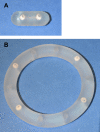Simultaneous delivery of tenofovir and acyclovir via an intravaginal ring
- PMID: 22123689
- PMCID: PMC3264253
- DOI: 10.1128/AAC.05662-11
Simultaneous delivery of tenofovir and acyclovir via an intravaginal ring
Abstract
Vaginal microbicides may play an important role in protecting women from HIV infection. A strong synergy between HSV and HIV has been observed, and epidemiological studies demonstrate that HSV infection increases the risk of HIV acquisition. Incorporation of the antiretroviral tenofovir (TFV) along with the antiherpetic acyclovir (ACV) into combination intravaginal rings (IVRs) for sustained mucosal delivery of both compounds could lead to increased microbicide product adherence and efficacy compared with conventional vaginal formulations. A novel, dual-protection "pod IVR" platform developed in-house and delivering ACV and TFV was evaluated in rabbit and sheep models. The devices were safe and exhibited sustained release of both drugs independently and at controlled rates over the 28-day studies. Daily release rates were estimated based on residual drug content of the used devices: rabbits, 343 ± 335 μg day(-1) (ACV) and 321 ± 207 μg day(-1) (TFV); sheep, 174 ± 14 μg day(-1) (ACV) and 185 ± 34 μg day(-1) (TFV). Mean drug levels in sheep vaginal samples were as follows: secretions, 5.25 ± 7.31 μg ml(-1) (ACV) and 20.6 ± 16.2 μg ml(-1) (TFV); cervicovaginal lavage fluid, 118 ± 113 ng ml(-1) (ACV) and 191 ± 125 ng ml(-1) (TFV); tissue, 173 ng g(-1) (ACV) and 93 ng g(-1) (TFV). An in vitro-in vivo correlation was established for both drugs and will allow the development of future formulations delivering target levels for prophylaxis and therapy. These data suggest that the IVR based on the pod design has potential in the prevention of transmission of HIV-1 and other sexually transmitted pathogens.
Figures






References
-
- Reference deleted.
-
- American Congress of Obstetricians and Gynecologists 2000. Practice bulletin, management of anovulatory bleeding, clinical management guidelines for obstetrician-gynecologists, p. 1049–1056 ACOG 2009 compendium, vol. 14 American Congress of Obstetricians and Gynecologists, Washington, DC
-
- Antoniou T, Park Wyllie LY, Tseng AL. 2003. Tenofovir: a nucleotide analog for the management of human immunodeficiency virus infection. Pharmacotherapy 23:29–43 - PubMed
-
- Barberini F, Desantis F, Correr S, Motta PM. 1992. The mucosa of the rabbit vagina—a proposed experimental model for correlated morphofunctional studies in humans. Eur. J. Obstet. Gynecol. Reprod. Biol. 44:221–227 - PubMed
Publication types
MeSH terms
Substances
Grants and funding
LinkOut - more resources
Full Text Sources
Other Literature Sources
Medical

